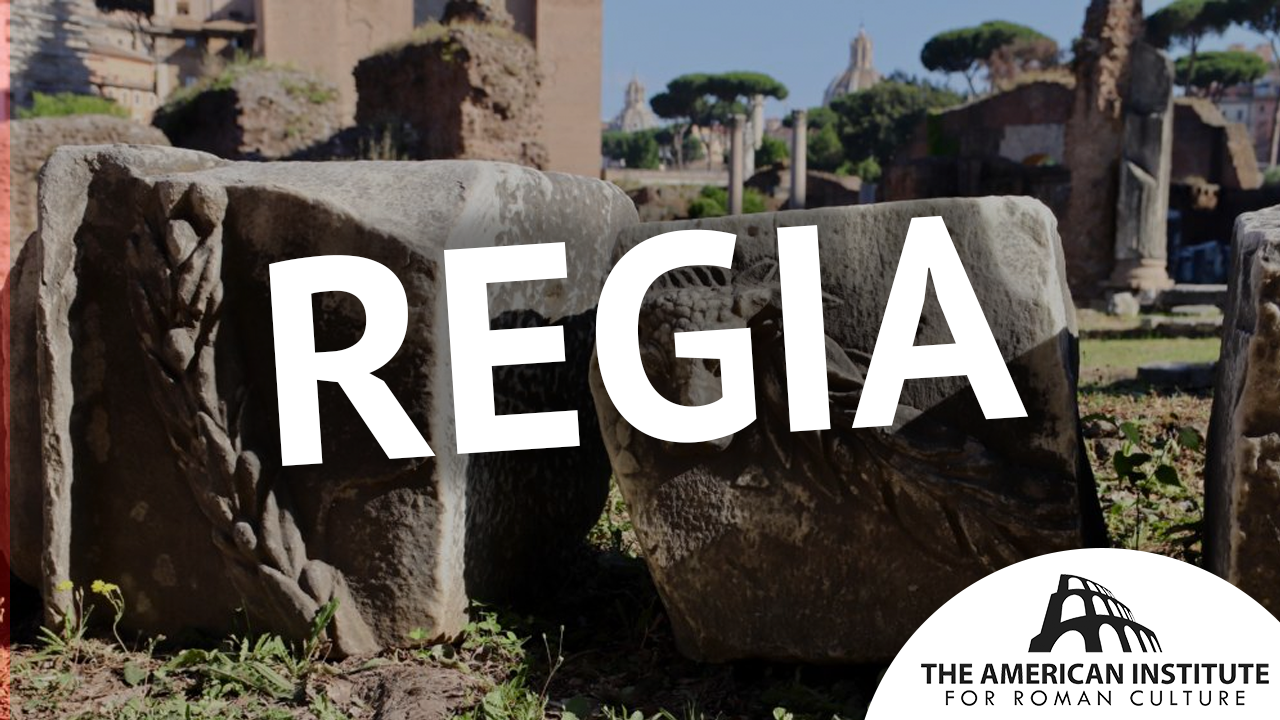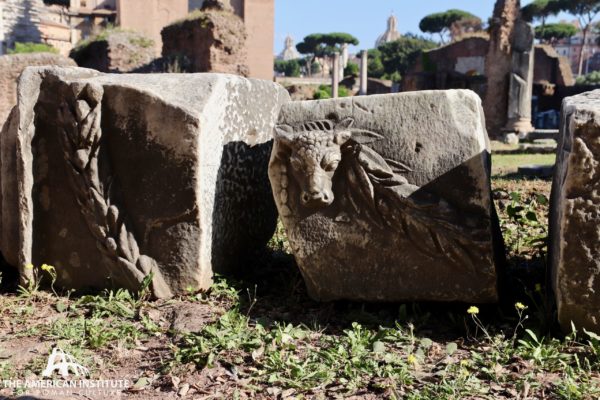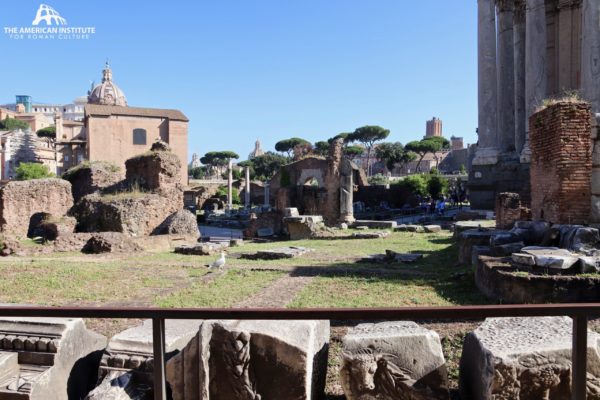Start with our video overview:
The Regia was an old (7C BC) structure that may have first been the king’s house in the regal period. By the time of the Augustus, it took on its definitive appearance, faced with Carrara marble. The structure had a number of shrines to Mars, Consiva, Ops. It was next to the Temple of Vesta and behind the Temple of Divus Julius.
Explore further:
REGIA (τὸ βασίλειον, App. Cass. Dio;τὸ βασίλειον οἴκημα, Plut.;῾Ρήγια,Plut. Cass. Dio): the house (regia domus) which Numa is said to have built, and either lived in (Solin. i. 21: Numa in colle primum Quirinali deinde propter aedem Vestae inregia quae adhuc appellatur; Ov. Trist. iii. I. 30; Fast. vi. 263-264; Serv. ad Aen. viii. 363: quis enim ignorat regiam ubi Numa habitavit in radicibus Palatifinibusque Romani fori esse ?; vii. 153; Tac. Ann. xv. 41), or at least used as his headquarters (Cass. Dio, frg. vi. 2: ὅτι ὁ Νουμᾶς ᾤκει ἐν Κολοϝῷ τῷΚυριϝαλίῳ … τὰ δὲ δὴ ἀρχεῖα ἐν τῇ ἱερᾷ ὁδῷ εἶχε καὶ τάς τεδιατριβὰς πλησίον τοῦ ῾Εστιαίου ἐποιεῖτο καὶ ἔστιν ὅτε καὶ κατὰχώρεω ἔμενεν; Plut. Numa 14:ἐδείματο πλησίον τοῦ τῆς ῾Εστίας ἱεροῦτὴν καλουμένην ῾Ρηγίαν οἷόν τι βασίλειον οἴκημα: καὶτὸ πλεῖστοναὐτόθι τοῦ χρόνου διέτριβεν). It is also said to have been the house of the pontifex maximus (Serv. ad Aen. viii. 363: domus enim in qua pontifex habitat regia dicitur, quod in ea rex sacrificulus habitare consuesset, sicut flaminia domus in qua flamen habitat, dicebatur (the italicised words are interpolated); cf. Jord. i. 2. 299); and of the rex sacrorum (Serv. loc. cit.; ii. 57: flaminiaautem domus flaminis dicitur sicut regia regis domus; Cass. Dio liv. 27, where Augustus is said to have given the house of the rex to the Vestals because it adjoined theirs; Fest. 279: regia domus ubi rex habitat). This latter statement, however, is the result of confusion between rex and rex sacrorum (Jord. cit.), for the domus regis sacrorum or sacrificuli was on the Velia and had no connection with the regia (Fest. 293: ne eatenus quidem sacra (via) appellandaest a regia ad domum regis sacrificuli sed etiam a regis domo ad sacellumStreniae). On the other hand, the regia could not have been the dwelling-house of the pontifex maximus, for in historical times it was a consecrated fanum containing sacraria (Fest. 278: (Regia). . .quod in fanum a pon(tifice) .. . tantquod in ea sa(cra fiunt quaedam a rege sol>ita usurpari; cf. 329). The actual house of the pontifex was probably the domus publica, in the precinct of the Atrium Vestae (Suet. Caes. 46; Cass. Dio liv. 24; RE i. A. 466), until Augustus transferred this residence to the Palatine (Van Deman, The Atrium Vestae 11, 12, 13).
During the republic, therefore, the regia was the official headquarters of the pontifex maximus, and its position, directly north-west of the aedes Vestae, is made certain by the existing ruins (cf. Hor. Carm. i. 2. 15: vidimus flavumTiberim… ire deiectum monumenta regis templaque Vestae). In it was a shrine of Mars, sacrarium Martis, in which were kept the hastae and ancilia of that god (Serv. Aen. vii. 188, 603; viii. 3; Gell. iv. 6. 1, 2; Cass. Dio xliv. 7 ; Iul. Obs. 6. 36, 44, 44 a, 47, 50 (ed. Rossbach); WR 503, 556; Jord. ii. 271-272; RE i. A. 1880; cf., however, Becker, Top. 229-232; RE i. 2113); and the sacrarium Opis Consivae (Varro, LL vi. 21: Opeconsiva dies ab dea Opeconsiva quoius in regiasacrarium quod ideo artum ut eo praeter virgines Vestales et sacerdotempublicum introeat nemo; Fest. 186, 249; Fast. Arv. a. d. viii Kal. Sept. vi. 32482, CIL i². p. 237; WR 203, 502). Certain sacrifices are recorded as having been performed in the regia (Varro vi. 12; Fest. 329; Macrob. i. 15. 19, 16. 30), a sheep was offered to Janus on 9th January by the rex sacrorum (CIL i². p. 306), and the blood of the October horse was sprinkled on its hearth and the head fastened on its wall (Fest. 178; Plut. q. Rom. 97; cf. Cass. Dio xliii. 24; and seeBC 1920, 152-162). The archives of the pontifices were probably kept here, for the tablets from which the annales maximi were edited, were hung on the outer wall of the building (Cic. de leg. i. 2. 6 ; Gell. ii. 28. 6; Dionys. i. 76. 3), and it was the place of assembly of the college of pontiffs (Plin. Ep. iv. II. 6; Cic. ad Att. x. 3 a, I; WR 503), and at times of the Fratres Arvales (CIL vi. 2023. 9). ATRIUM REGIUM (q.v.) is referred to the regia by Jord. i. 2. 380, and Toeb. 3.
The regia was burned and restored in 148 B.C. (Obseq. 19; Liv. epit. Oxyrh. 127-129; Gilb. iii. 407 (for a possible burning by the Gauls in 390 B.C., see Mem. Am. Acad. ii. 59-60)); and again in 36 B.C., when the restoration was carried out by Cn. Domitius Calvinus who created a building, small but of unusual beauty (Cass. Dio xlviii. 42; cf. Plin. NH xxxiv. 48; CIL vi. 1301 ; EE iii. 266). The evidence of the ruins shows that the statement of Tacitus (Ann. xv. 41) that the regia was destroyed in the fire of Nero is greatly exaggerated (for possible injury by the great fire in Commodus’ reign, see Herodian i. 14. 3). The building is represented on a fragment of the Marble Plan (21), and is mentioned in the third century (Solin. loc. cit.) and probably in the fourth (CIL vi. 511).
The existing ruins belong to three periods, the republican, the early imperial and the medieval. Of the superstructure of the first two periods almost nothing remains except the lowest courses of some of the walls and many architectural fragments. The republican remains are found only in the foundations of the imperial structure, the ground plan of which is practically identical.
There are traces of the repairs of 148, while the walls of cappellaccio probably date from well before the fire of 390 B.C. After the restoration of Calvinus the regia was shaped like an irregular pentagon, filling the space between the Sacra via, the temenos of Vesta, and the temple of Julius Caesar, and consisting of parts unsymmetrically joined together. The principal part was trapezoidal, with a mean length of about 22 metres and a width of 8 metres, and was built of solid blocks of white marble, with a pavement of marble slabs. Some fragments of the cornice in this material are preserved.1 On the west and south sides were inscribed in four double panels the fasti consulares, and on the pilasters of the south side, the fasti triumphales, and many of the fragments of these blocks have been preserved and are now in the Palazzo dei Conservatori (Mitt. 1904, 117-123; 1905, 77-80; NS 1904, 8-10; 1925, 376-382; 1926, 62-67; YW 1925-6, iii; BC 1904, 188; 1925, 238-270; WS 1902, 324-325; LS ii. 197-200; RE vi. 2027-2045).
The interior was divided into three rooms, in the largest of which was found a pavement of Anio tufa blocks (perhaps therefore post-Sullan), and in this a circular substructure of grey tufa, 2.53 metres in diameter, dating from the early period.2 There was a doorway in the original building, but it was roughly widened for the mediaeval house, and two rude steps placed in front of it.
The irregular space between this part of the regia and the Sacra via was occupied by an open court, with a covered ante-chamber at the east end, where the main entrance seems to have been. The greatest width, north and south, of the area of the regia was about 27 metres, and the least about 12 metres. The court was paved with slabs of marble, and in it are two wells and a cistern, which may date from a very early time, though Frank assigns the greater age to the main (trapezoidal) building, and contained fragments of various kinds. Near the cistern is a base of tufa blocks, with traces of a circular superstructure. To this may belong the round block of peperino with the inscription A. COVRI (second century B.C.).3 At the south-west end of the marble building is a small room, and near this in the wall was found the inscription (NS 1899, 128) of the SCHOLA KALATORUM (q.v.), but no identification of any of the existing divisions of the ruins with any of the parts of the ancient regia mentioned in classical literature is possible.
In the seventh or eighth century the regia was transformed into a private house, the traces of which are visible in all parts of the area, but especially along the Sacra via, where the house was approached by a flight of two steps roughly made of marble and travertine, on which stood a row of cipollino columns taken from some ancient building.
Literature: general-Jord. i. 2. 298-304, 423-429; Gilb. i. 225-227, 305-310, 341-352; iii. 407-410; Thedenat 91-94, 274-277; HC 180-185; RE i. A. 465-469; WR 502; LR 221-223; RL xix. 1910, 201-216, where Pais argues that the regia and Vesta cult were not established in the forum until the fourth century B.C.; for recent excavations-Mitt. 1886, 94-98, 99-111; 1902, 62-66; 1905, 77-80; 1921, 17-23; Archaeologia, 1887, 227-250; Jahrb. d. Inst. 1889, 228-253; NS 1899,220-223,384-386, 486-488; BC 1899, 205-213; 1903, 42-55; 1920, 152-162; CR 1899, 322, 466; 1901, 139; AA 90000, 6-8; Atti 518-525; Toeb. 1-12; TF 81-85; DR 249-274; HFP 36, 37.
This content is brought to you by The American Institute for Roman Culture, a 501(C)3 US Non-Profit Organization.
Please support our mission to aid learning and understanding of ancient Rome through free-to-access content by donating today.
Cite This Page
Cite this page as: Darius Arya, The American Institute for Roman Culture, “Regia” Ancient Rome Live. Last modified 01/24/2020. https://ancientromelive.org/regia/
License
Created by The American Institute of Roman Culture, published on 01/24/2020 under the following license: Creative Commons: Attribution-NonCommercial-ShareAlike. This license lets others remix, tweak, and build upon this content non-commercially, as long as they credit the author and license their new creations under the identical terms. Please note that content linked from this page may have different licensing terms.





